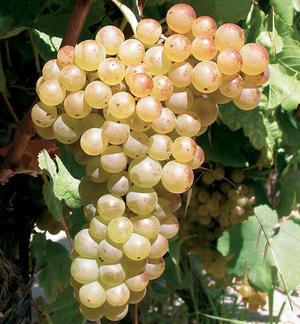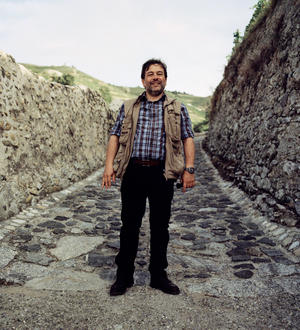2018 Ermitage Blanc, De L'Orée, M. Chapoutier, Rhône
- White
- Dry
- Full Bodied
- Marsanne
Ready - youthful
- 95/100
- Josh Raynolds
- 96/100
- Jeb Dunnuck
- 98+/100
Product: 20188116763
Colour White
Sweetness Dry
Vintage 2018
Alcohol % 14
Maturity Ready - youthful
Grape List Marsanne
Body Full Bodied
Producer Maison Chapoutier
Critics reviews
95/100
This has weight but perhaps not quite the depth of some more recent vintages of de l'Orée, however it does have a little more juice with a good sense of freshness and length even if the acidity is low. A little more floral in style than most recent vintages with balanced alcohol. From 70-year-old vines from the lieu-dit Les Murets. All matured in demi muid with 15% new oak.Drink 2022-2030Decanter (Oct 2019)
Drink 2022 - 2030
Josh Raynolds 96/100
Brilliant straw-gold. Powerful, mineral-accented orchard and pit fruit aromas are complemented by lemon curd, iodine and pungent floral accents. Intense, palate-staining pear nectar and Meyer lemon flavors show superb concentration. Definition and a sexy floral nuance build through the mid-palate. Opens up steadily on an extremely long, floral-tinged finish that emphatically echoes the pit fruit and mineral notes.Drink 2024-2034josh_raynolds, Vinous.com (May 2020)
Drink 2022 - 2030
Jeb Dunnuck 98+/100
Leading off the single vineyard Hermitage whites, the 2018 Ermitage De L’Orée is all Marsanne, from the Les Murets lieu-dit, brought up mostly in used demi-muids. Orange blossom, crushed citrus, spice box, white flowers, beautiful minerality, and vivid charcoal notes emerge from the glass of this beautiful, concentrated, opulent Hermitage, which has a stacked mid-palate and a level of structure fitting for a red wine. It's a brilliant wine that's going to benefit from 2-4 years of bottle age and keep for 20+ .This was another stunning tasting with the team at Chapoutier. They’ve produced some of the wines of the vintage in both 2017 and 2018. The team here compares 2017 to 2007, which is a comparison I understand, even if I think the quality of their 2017s are a step up. Both vintages were hot and dry, and the wines have expressive, sunny profiles. I reviewed their top 2017 dry whites last year, but the 2017 reds showed spectacularly well this year, most coming in at the upper end of their barrel range. Looking at the 2018s, this is another blockbuster year at this estate and the wines reveal even deeper purple (almost blue) hues compared their 2017 counterparts as well as a touch more freshness in their aromatics reminiscent of a cooler vintage. Nevertheless, these are big, rich, concentrated wines that have building tannins and structure as well as loads of fruit, and are built for the cellar. One of the beauties of the 2018s is that the wines have a wonderful sense of freshness and purity reminiscent of a cooler year, yet paired with the fruit, depth, and richness of a warmer year. Lastly, the lineup here seems to grow each year and at present, includes two sparkling wines, three Saint-Péray, two Condrieu, two Cornas, four Côte Rôtie, six Crozes Hermitage, nine Hermitage, and six Saint Joseph. Also, there are a handful of Vin de France and IGP releases. The top “Sélections Parcellaires” cuvées range from 300 to 1,000 cases, and while they can be frightfully expensive, they’re among the greatest wines in the world. However, don’t overlook the value releases from Chapoutier, where you get serious bang for the buck.Drink 2022-2042jeb_dunnuck , jebdunnuck.com (Dec 2019)
Drink 2022 - 2030
About this wine

Marsanne
Marsanne is the predominant white grape variety grown in the Northern Rhône where it is used to produce white St. Joseph, Crozes-Hermitage, and Hermitage. It is a tricky grape to cultivate, being susceptible to diseases and being particularly sensitive to extreme climatic changes - if growing conditions are too cool, then it fails to ripen fully and produces thin, insipid wines, while, if too hot, the resultant wines are blowsy, overblown and out of balance.
Find out more

Maison Chapoutier
Applying his usual break-neck rigour to the presidency of InterRhône has not in any way distracted Michel Chapoutier. His range is more impressive in scope than ever, providing the most complete dissection of the region’s styles and terroir. Founded in 1808, Michel took charge in 1988 and became the seventh generation of his family to run the domaine. Since then, quality has soared and he is now farming all his vineyards biodynamically. He also invests in new winemaking projects across the globe, as far-flung as Australia. His children, in particular his daughter, Mathilde, are now increasingly involved in the day-to-day management of the maison, bringing with her her entrepreneurial skills and vision.
Find out more
